Human–Computer Interaction Based on Scan-to-BIM Models, Digital Photogrammetry, Visual Programming Language and eXtended Reality (XR)
Abstract
:1. Introduction
2. Motivation and Main Contributions
3. State-of-the-Art
- Parametricity,
- Interoperability,
- Orientation and
- Virtual interactivity.
4. Method
4.1. The Research Case Study and Its Cultural–Historical Background
4.2. 3D Survey: Aerial and Terrestrial Photogrammetry of the Church of San Valentino in Siusi, Italy
4.3. The Paradigm of Complexity in Built Heritage and Architecture Representations: From Simple Points to HBIM Objects
4.4. Model Generation and Information Mapping
- Import of point clouds and textured models from digital photogrammetry into NURBS modelling software;
- Integrated application of GOG 9 and GOG 10 for the generation of complex and unique elements such as the complex vaulted system of the church, out-of-plumb walls, structural elements, roof and bell tower;
- Automatic transformation of complex NURBS elements into HBIM objects for the creation and sharing of a BIM project, schedules, two-dimensional drawings;
- Information mapping: insertion of information for each HBIM element created to expand the digital model’s information value.
- wedge-shaped pieces called voussoirs which are held in place by the pressure of the neighbouring pieces;
- abutments: a structure to support the lateral pressure of an arch or span;
- imposts: top course of a pillar or a wall that supports the arch;
- intrados: inner curve and surface of an arch or vault;
- estrados: determination of the wall thickness of the vault (through the GOG 10, it is possible to hypothesise the thickness parameter and update it according to subsequent inquiries);
- keystones: the intersection of the ribs of a rib vault. It is structurally important since it marks the apex of the vault;
- diagonal ribs: diagonal elements between two walls to divide a vault into bays. An arch of masonry, often moulded, forms part of the framework on which a vault rests. Ribs generally project from the undersurface of the vault.
4.5. Information Sharing: Transforming 3D Survey and HBIM Models in XR Projects
4.5.1. HBIM Interoperability for eXtended Reality (XR): From HBIM Models to Virtual Reality
4.5.2. Augmented Reality for Built Heritage: Towards Augmented Information of Interactive Virtual Object Library
- Limited amount of poles, at most five edges.
- Polycount for Unity AR: individual model 50K tris max. The whole scene must be 250K tris max.
- The number of materials and textures impact performance significantly more strongly than polycount.
- 3D models should have no extraneous helpers, shapes, splines, or other objects not specifically needed for the model functionality.
- 3D models should include a grouping or hierarchy allowing all objects in the model to be moved together.
5. Discussion
6. Conclusions and Remarks
Author Contributions
Funding
Institutional Review Board Statement
Informed Consent Statement
Data Availability Statement
Acknowledgments
Conflicts of Interest
References
- Dore, C.; Murphy, M. Integration of HBIM and 3D GIS for Digital Heritage Modelling. In Proceedings of the Digital Documentation, Edinburgh, UK, 22–23 October 2012. [Google Scholar]
- Brumana, R.; Georgopoulos, A.; Oreni, D.; Raimondi, A.; Bregianni, A. HBIM for documentation, dissemination and management of built heritage. The case study of St. Maria in Scaria d’Intelvi. Int. J. Herit. Digit. Era 2013, 2, 433–451. [Google Scholar] [CrossRef] [Green Version]
- Banfi, F. BIM Orientation: Grades of Generation and Information for Different Type of Analysis and Management Process. Int. Arch. Photogramm. Remote Sens. Spat. Inf. Sci. 2017, 42, 57–64. [Google Scholar] [CrossRef] [Green Version]
- Fai, S.; Sydor, M. Building Information Modelling and the documentation of architectural heritage: Between the ‘typical’ and the ‘specific’. In Proceedings of the 2013 Digital Heritage International Congress (Digital Heritage) IEEE, Marseille, France, 28 October–1 November 2013; Volume 1, pp. 731–734. [Google Scholar]
- Gironacci, I.M. State of the Art of Extended Reality Tools and Applications in Business. In Transdisciplinary Perspectives on Risk Management and Cyber Intelligence; IGI Global: Hershey, PA, USA, 2021; pp. 105–118. [Google Scholar]
- Inzerillo, L.; Lo Turco, M.; Parrinello, S.; Santagati, C.; Valenti, G.M. BIM e beni architettonici: Verso una metodologia operativa per la conoscenza e gestione del patrimonio culturale. DisegnareCon Le Dimens. Del BIM 2016, 9, 161–169. [Google Scholar]
- Chiabrando, F.; Sammartano, G.; Spanó, A.T. Historical Building Models and their handling via 3D survey: From points clouds to user-oriented HBIM. Int. Arch. Photogramm. Remote Sens. Spat. Inf. Sci. 2016, XLI-B5, 633–640. [Google Scholar] [CrossRef] [Green Version]
- Banfi, F.; Chow, L.; Reina Ortiz, M.; Ouimet, C.; Fai, S. Building Information Modeling for Cultural Heritage: The Management of Generative Process for Complex Historical Buildings. In Digital Cultural Heritage; Ioannides, M., Ed.; Lecture Notes in Computer Science; Springer: Cham, Switzerland, 2018; Volume 10605, pp. 119–130. [Google Scholar]
- Diara, F.; Rinaudo, F. From reality to parametric models of cultural heritage assets for HBIM. Int. Arch. Photogramm. Remote Sens. Spat. Inf. Sci. 2019, XLII-2/W15, 413–419. [Google Scholar] [CrossRef] [Green Version]
- Bruno, N.; Roncella, R. A restoration oriented HBIM system for cultural heritage documentation: The case study of Parma cathedral. Int. Arch. Photogramm. Remote Sens. Spat. Inf. Sci. 2018, XLII-2, 171–178. [Google Scholar] [CrossRef] [Green Version]
- Simeone, D.; Cursi, S.; Toldo, I.; Carrara, G. B(H)IM-Built Heritage Information Modelling–Extending BIM approach to historical and archaeological heritage representation. In Proceedings of the 32nd eCAADe Conference, Newcastle upon Tyne, UK, 10–12 September 2014; Volume 1, pp. 613–622. [Google Scholar]
- Costantino, D.; Pepe, M.; Restuccia, A.G. Scan-to-HBIM for conservation and preservation of Cultural Heritage building: The case study of San Nicola in Montedoro church (Italy). Appl. Geomat. 2021, 1–15. [Google Scholar] [CrossRef]
- Bosch, A.; Volker, L.; Koutamanis, A. BIM in the operations stage: Bottlenecks and implications for owners. Built Environ. Proj. Asset Manag. 2015, 5, 331–343. [Google Scholar] [CrossRef]
- López, F.J.; Lerones, P.M.; Llamas, J.; Gómez-García-Bermejo, J.; Zalama, E. Linking HBIM graphical and semantic information through the Getty AAT: Practical application to the Castle of Torrelobatón. In Proceedings of the IOP Conference Series: Materials Science and Engineering, Florence, Italy, 16–18 May 2018; Volume 364, p. 012100. [Google Scholar]
- Pauwels, P.; De Meyer, R.; Van Campenhout, J. Interoperability for the design and construction industry through semantic web technology. In Proceedings of the International Conference on Semantic and Digital Media Technologies 2010, Saarbrücken, Germany, 1–3 December 2010; pp. 143–158. [Google Scholar]
- Roberts, C.J.; Pärn, E.A.; Edwards, D.J.; Aigbavboa, C. Digitalising asset management: Concomitant benefits and persistent challenges. Int. J. Build. Pathol. Adapt. 2018, 36, 152–173. [Google Scholar] [CrossRef]
- Visintini, D.; Marcon, E.; Pantò, G.; Canevese, E.P.; De Gottardo, T.; Bertani, I. Advanced 3d Modeling Versus Building Information Modeling: The Case Study of Palazzo Ettoreo in Sacile (Italy). Int. Arch. Photogramm. Remote Sens. Spat. Inf. Sci. 2019, 42, 1137–1143. [Google Scholar] [CrossRef] [Green Version]
- Terkaj, W.; Šojić, A. Ontology-based representation of IFC EXPRESS rules: An enhancement of the ifcOWL ontology. Autom. Constr. 2015, 57, 188–201. [Google Scholar] [CrossRef]
- Costa, G.; Madrazo, L. Connecting building component catalogues with BIM models using semantic technologies: An application for precast concrete components. Autom. Constr. 2015, 57, 239–248. [Google Scholar] [CrossRef]
- BuildingSMART: Linked DataWorking Group. 2018. Available online: https://technical.buildingsmart.org/standards/ifc/ifc-formats/ifcowl/ (accessed on 3 January 2020).
- Kang, T.; Choi, H. BIM perspective definition metadata for interworking facility management data. Adv. Eng. Inform. 2015, 29, 958–970. [Google Scholar] [CrossRef]
- Allemang, D.; Hendler, J. Semantic Web for the Working Ontologist: Effective Modeling in RDFS and OWL; Morgan Kaufmann: Burlington, MA, USA, 2011. [Google Scholar]
- Brumana, R.; Ioannides, M.; Previtali, M. Holistic heritage building information modelling (HHBIM): From nodes to hub networking, vocabularies and repositories. In Proceedings of the 2nd International Conference of Geomatics and Restoration, GEORES 2019, Milan, Italy, 8–10 May 2019; Volume 42, pp. 309–316. [Google Scholar]
- Niknam, M.; Karshenas, S. A shared ontology approach to semantic representation of BIM data. Autom. Constr. 2017, 80, 22–36. [Google Scholar] [CrossRef] [Green Version]
- Piccoli, E. Volte composte nell’architettura piemontese del Settecento: Le volte planteriane. PALLADIO 1999, VII, 87–100. [Google Scholar]
- Knublauch, H.; Oberle, D.; Tetlow, P.; Wallace, E.; Pan, J.Z.; Uschold, M. A Semantic Web Primer for Object-Oriented Software Developers. W3c Working Group Note, W3C. 2006. Available online: https://www.w3.org/TR/sw-oosd-primer/ (accessed on 3 January 2020).
- Quattrini, R.; Pierdicca, R.; Morbidoni, C. Knowledge-based data enrichment for HBIM: Exploring high-quality models using the semantic-web. J. Cult. Herit. 2017, 28, 129–139. [Google Scholar] [CrossRef]
- Stöcker, C.; Eltner, A.; Karrasch, P. Measuring gullies by synergetic application of UAV and close range photogrammetry—A case study from Andalusia, Spain. Catena 2015, 132, 1–11. [Google Scholar] [CrossRef]
- Besl, P.J.; McKay, N.D. Method for registration of 3-D shapes. In Sensor Fusion IV: Control Paradigms and Data Structures; International Society for Optics and Photonics: Bellingham, WA, USA, 1992; pp. 586–606. [Google Scholar]
- Oreni, D.; Brumana, R.; Georgopoulos, A.; Cuca, B. HBIM for conservation and management of built heritage: Towards a library of vaults and wooden beam floors. In ISPRS Annals of Photogrammetry, Remote Sensing and Spatial Information Sciences; Grussenmeyer, P., Ed.; Copernicus Publications: Göttingen, Germany, 2013; Volume II-5/W1, pp. 215–221. [Google Scholar]
- Altun, M.; Akcamete, A. A method for facilitating 4D modeling by automating task information generation and mapping. In Advances in Informatics and Computing in Civil and Construction Engineering; Springer: Cham, Switzerland, 2019; pp. 479–486. [Google Scholar]
- Brumana, R.; Stanga, C.; Banfi, F. Models and scales for quality control: Toward the definition of specifications (GOA-LOG) for the generation and re-use of HBIM object libraries in a Common Data Environment. Appl. Geomat. 2021, 1–29. [Google Scholar] [CrossRef]
- Brumana, R.; Condoleo, P.; Grimoldi, A.; Landi, A.G.; Attico, D.; Turrina, A.; Banfi, F.; Previtali, M. HBIM Feeding Open Access Vault Inventory Through GeoDB HUB. In Proceedings of the Euro-Mediterranean Conference 2018, Nicosia, Cyprus, 29 October–3 November 2018; pp. 27–38. [Google Scholar]
- Barazzetti, L.; Banfi, F.; Brumana, R.; Previtali, M. Creation of parametric BIM objects from point clouds using NURBS. Photogramm. Rec. 2015, 30, 339–362. [Google Scholar] [CrossRef]
- Chiabrando, F.; Lo Turco, M.; Rinaudo, F. Modeling the decay in an HBIM starting from 3D point clouds. a followed approach for cultural heritage knowledge. Int. Arch. Photogramm. Remote. Sens. Spat. Inf. Sci. 2017, XLII-2/W5, 605–612. [Google Scholar] [CrossRef] [Green Version]
- Cogima, C.K.; Paiva, P.V.V.; Dezen-Kempter, E.; Carvalho, M.A.G.; Soibelman, L. The role of knowledge-based information on BIM for built heritage. In Advances in Informatics and Computing in Civil and Construction Engineering; Springer: Cham, Switzerland, 2019; pp. 27–34. [Google Scholar]
- Ioannides, M.; Magnenat-Thalmann, N.; Papagiannakis, G. Mixed Reality and Gamification for Cultural Heritage; Springer: Cham, Switzerland, 2017. [Google Scholar]
- Lerma, J.L.; Navarro, S.; Cabrelles, M.; Villaverde, V. Terrestrial laser scanning and close range photogrammetry for 3D archaeological documentation: The Upper Palaeolithic Cave of Parpalló as a case study. J. Archaeol. Sci. 2010, 37, 499–507. [Google Scholar] [CrossRef]
- Lo Turco, M.; Calvano, M.; Giovannini, E.C. Data modelling for museum collections. Int. Arch. Photogramm. Remote Sens. Spat. Inf. Sci. 2019, XLII-2/W9, 433–440. [Google Scholar] [CrossRef] [Green Version]
- Jung, K.; Nguyen, V.T.; Lee, J. BlocklyXR: An Interactive Extended Reality Toolkit for Digital Storytelling. Appl. Sci. 2021, 11, 1073. [Google Scholar] [CrossRef]
- Jang, J.; Ko, Y.; Shin, W.S.; Han, I. Augmented Reality and Virtual Reality for Learning: An Examination Using an Extended Technology Acceptance Model. IEEE Access 2021, 9, 6798–6809. [Google Scholar] [CrossRef]
- Pybus, C.; Graham, K.; Doherty, J.; Arellano, N.; Fai, S. New Realities for Canada’s Parliament: A Workflow for Preparing Heritage Bim for Game Engines and Virtual Reality. Int. Arch. Photogramm. Remote Sens. Spat. Inf. Sci. 2019, XLII-2/W15, 945–952. [Google Scholar] [CrossRef] [Green Version]
- Gruber, K. Kunst in der Pfarre Seis am Schlern; Lana Tappeiner: Merano, Italy, 1996; ISBN 88-7073-213-4. [Google Scholar]
- Gleirscher, P.; Nothdurfter, H.; Schubert, E. Das Rungger Egg: Untersuchungen an einem eisenzeitlichen Brandopferplatz bei Seis am Schlern in Südtirol. In Römisch-Germanische Forschungen; DAI: Darmstadt, Germany, 2002; p. 61. ISBN 3-8053-2826-5. [Google Scholar]
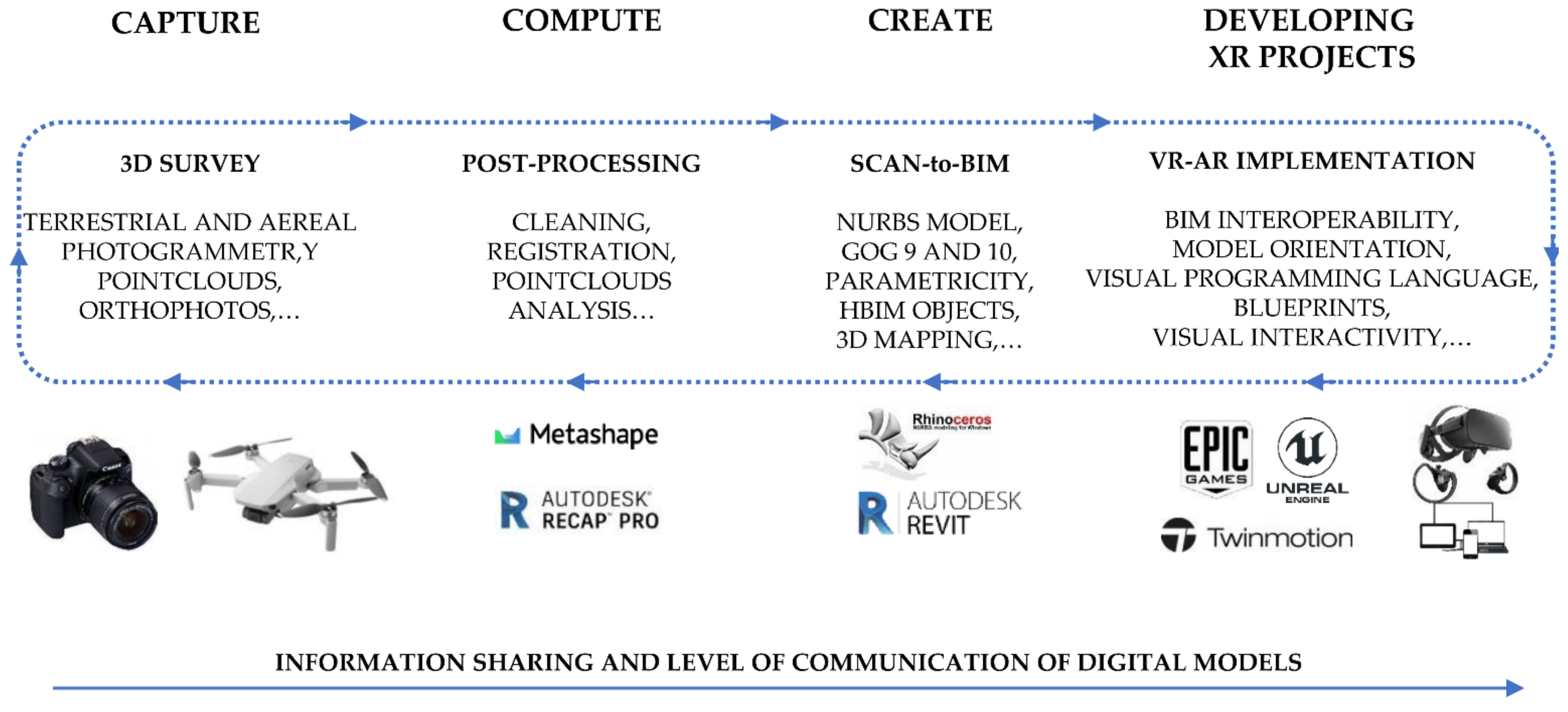





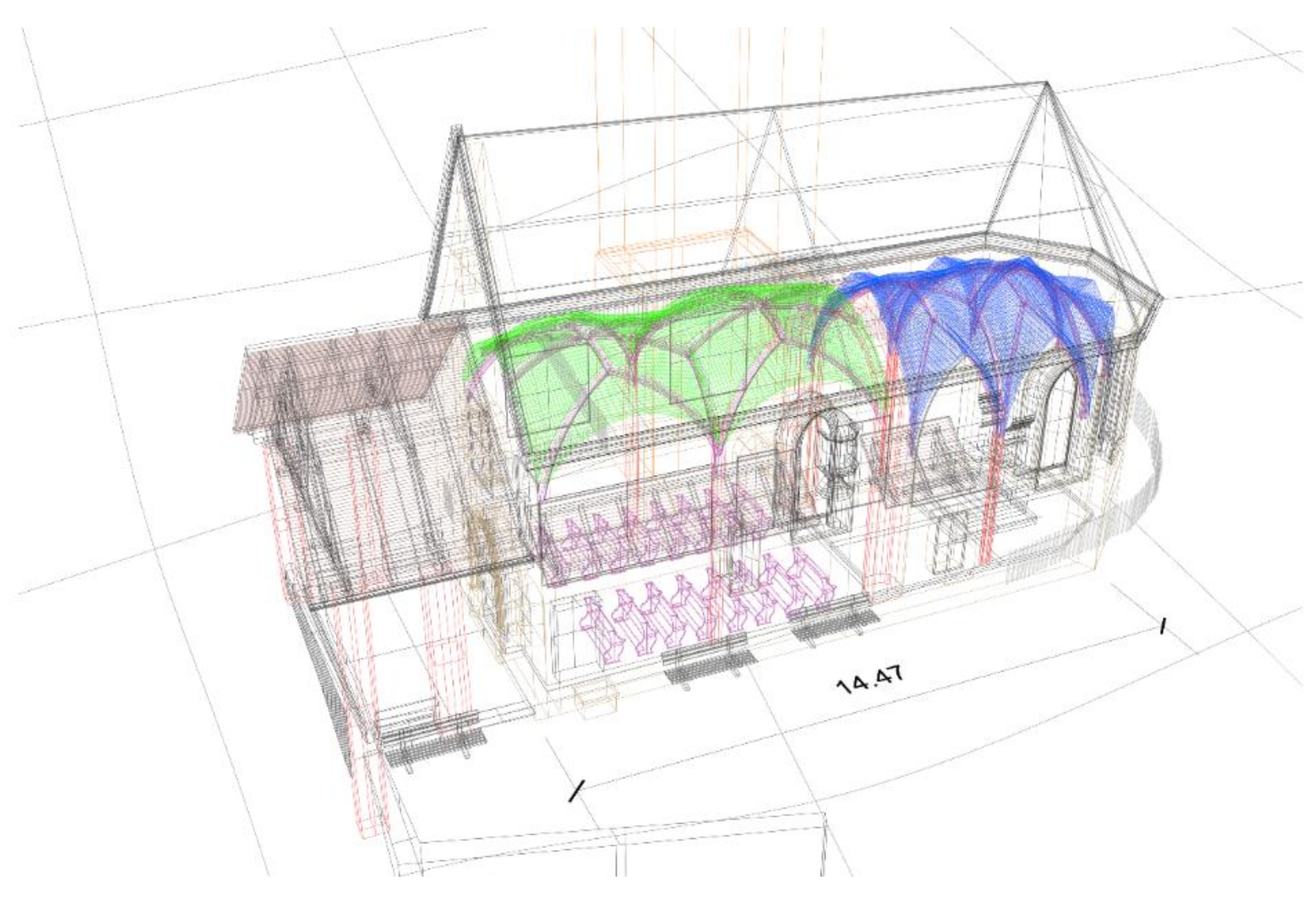

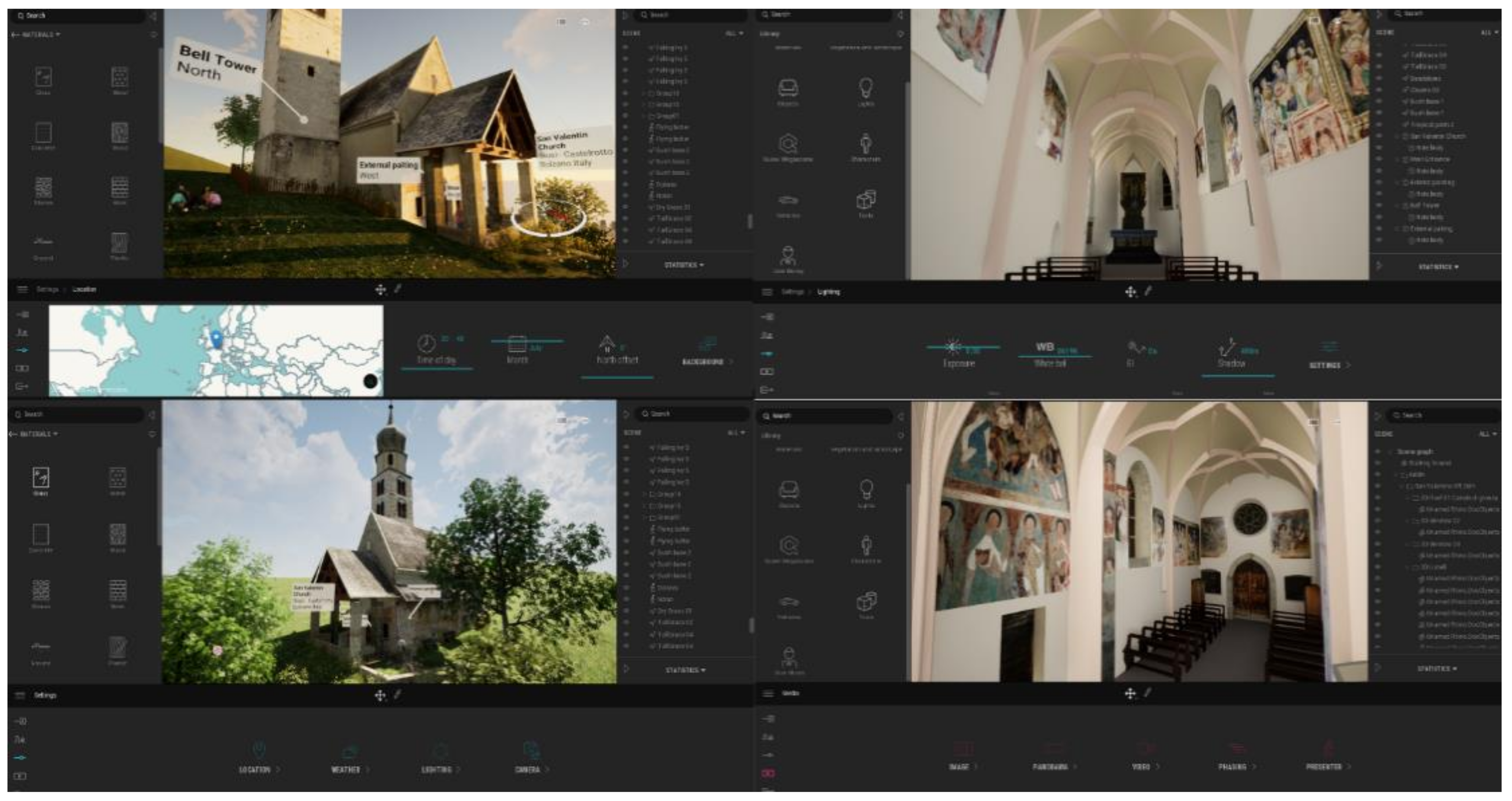
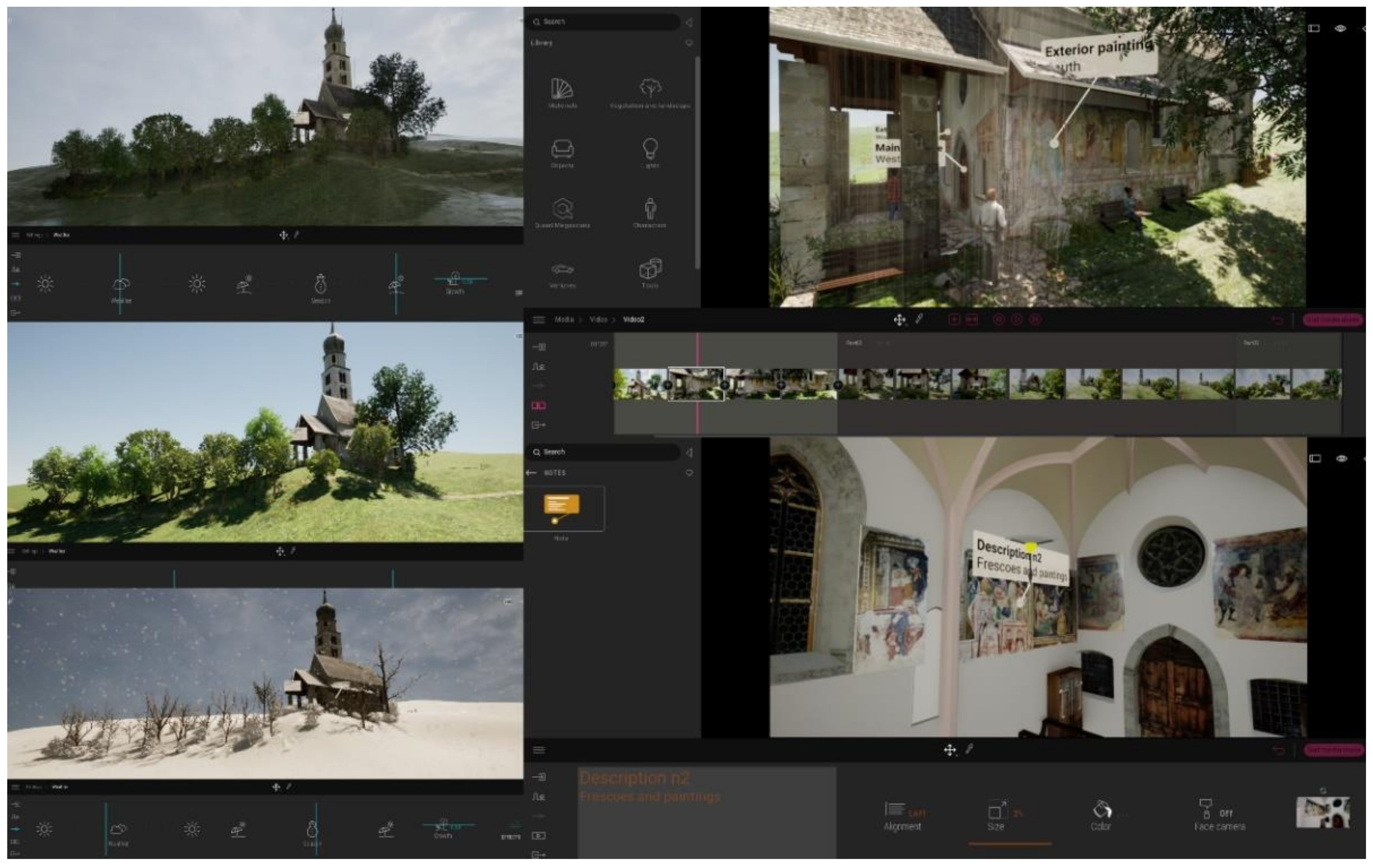
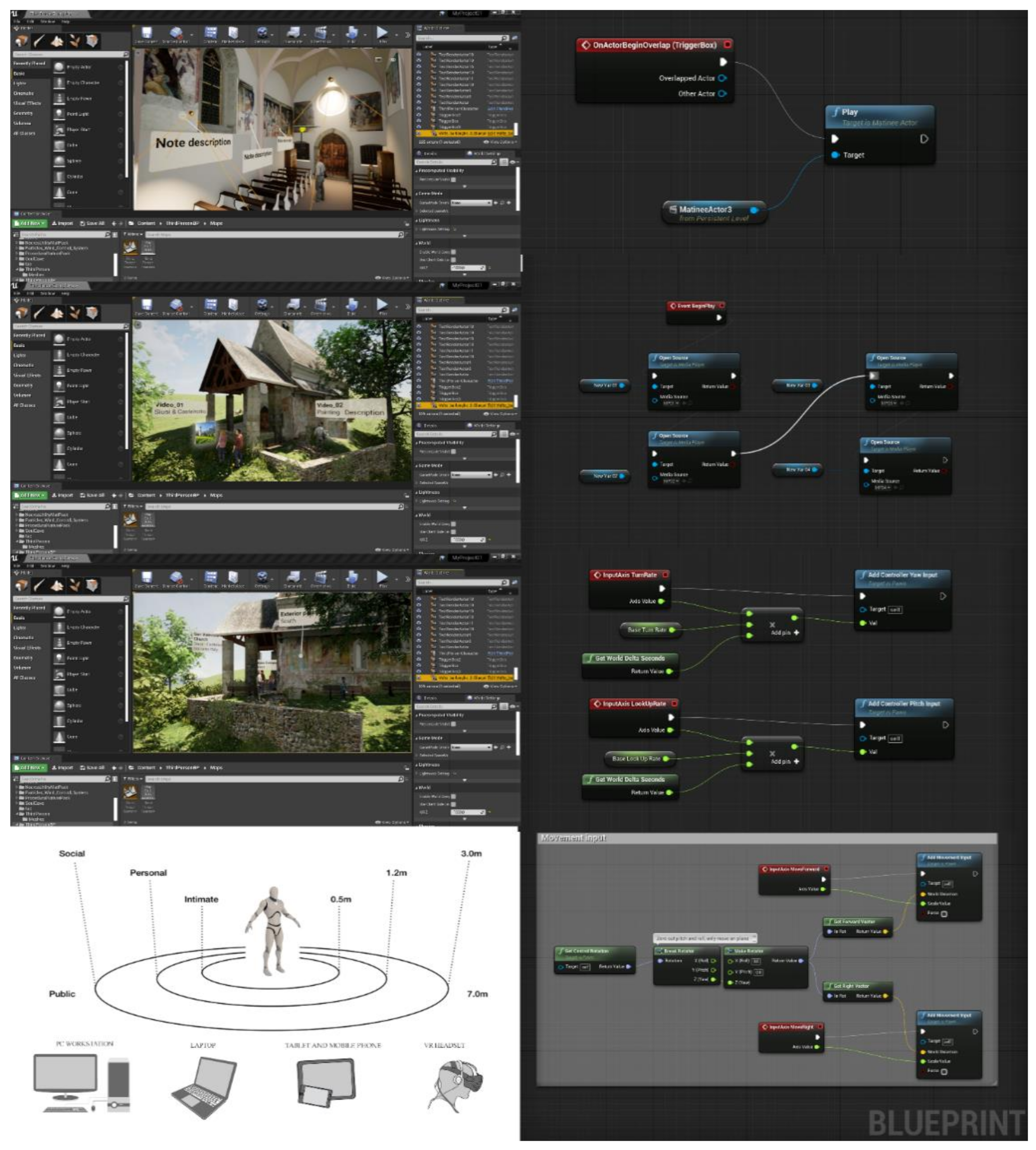
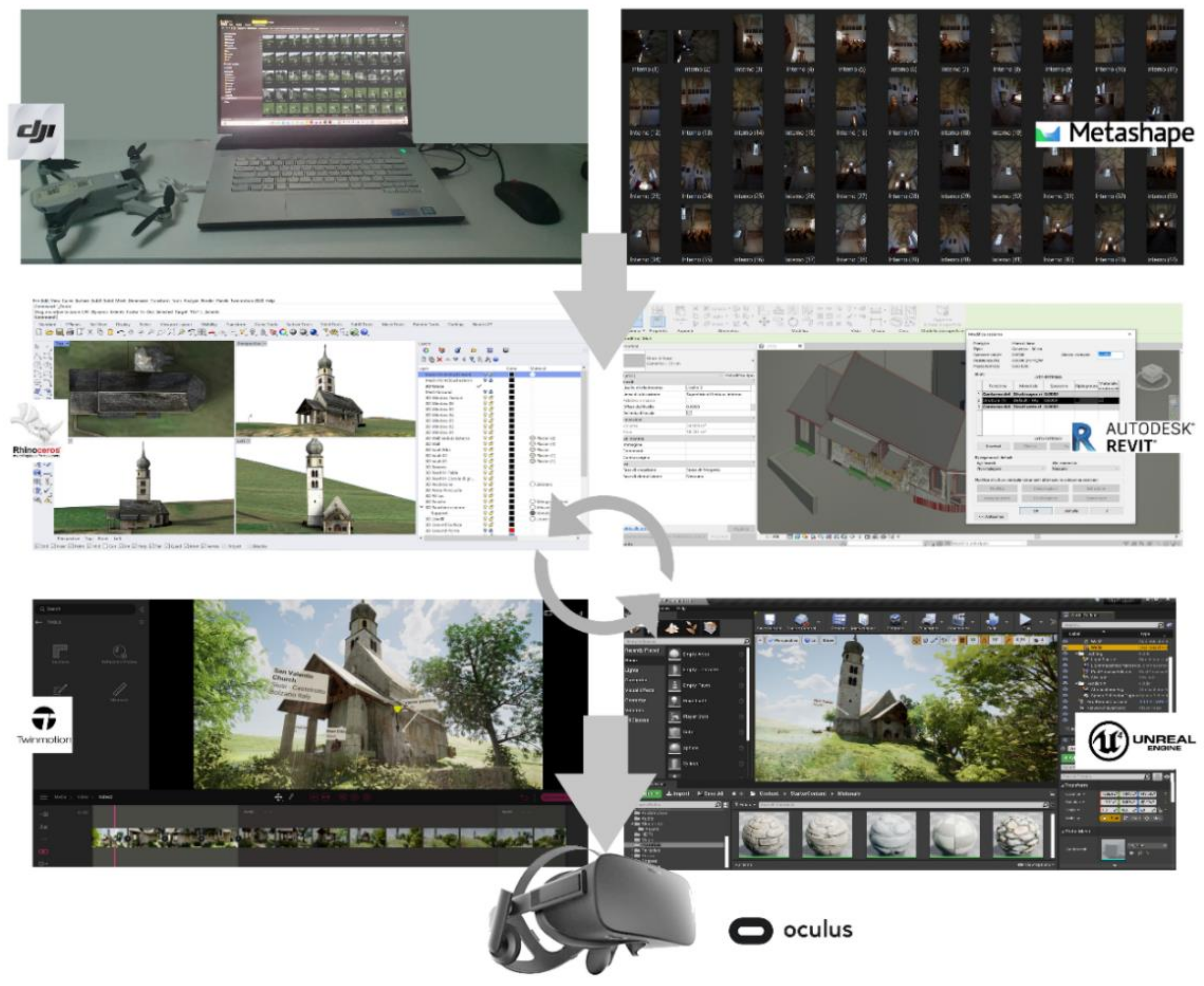
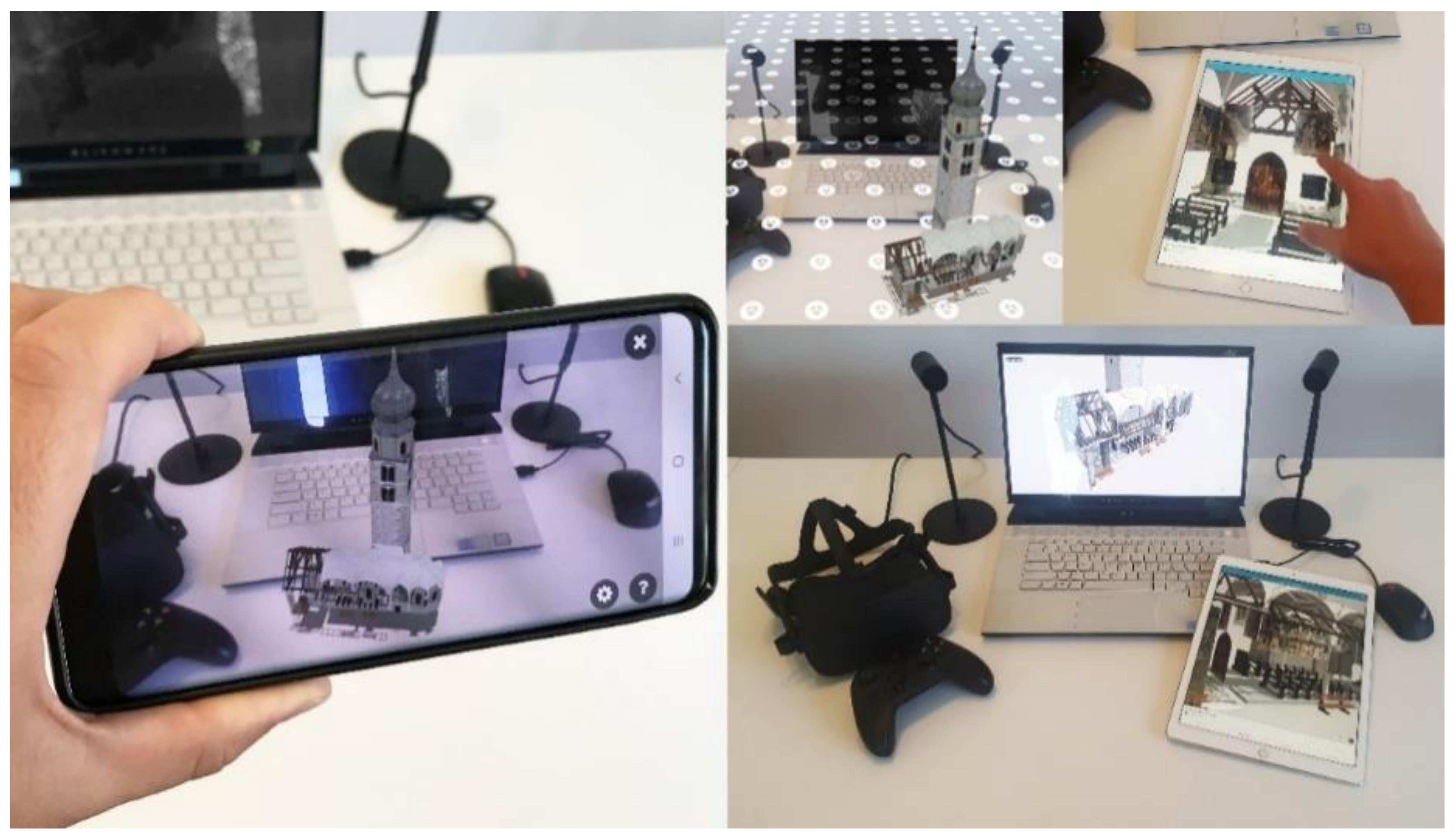
| Drone Platform | Terrestrial Platform 1 | |
|---|---|---|
| Camera | DJI FC7203 | SM-G975F (Samsung Galaxy S10+) |
| Focal | 4.49 mm | 4.32 mm |
| Sensor size | 6.475 mm × 4.856 mm | 5.751 mm × 4.313 mm |
| Average ground sampling distance | 0.005 m | 0.002 m |
| Acquisition mode | Nadir and oblique | - |
| Acquisition angle | Nadir −90° Oblique −40°/−10° | 0°/10° |
| Number of acquired images | 197 | 589 |
| Indoor Acquisition | |
|---|---|
| Camera | Sony A7 III |
| Focal | 12 mm |
| Sensor size | 35.6 mm × 23.8 mm |
| Average ground sampling distance | 0.002 mm |
| Acquisition mode | |
| Acquisition angle | 0°/50° |
| Number of acquired images | 52 |
| The Method Phases | Processing Time |
|---|---|
| 3D Survey | Tot. = 3 h |
| 2 h |
| 1 h |
| Post-processing | Tot. = 1 h |
| 40 min |
| 20 min |
| Scan-to-BIM | Tot. = 7 h |
| 3 h |
| 2 h |
| 2 h |
| XR Implementation | |
| Real-time synchronisation |
| 5 h |
| 1 h |
| This part depends on the information available for each specific object |
Publisher’s Note: MDPI stays neutral with regard to jurisdictional claims in published maps and institutional affiliations. |
© 2021 by the authors. Licensee MDPI, Basel, Switzerland. This article is an open access article distributed under the terms and conditions of the Creative Commons Attribution (CC BY) license (https://creativecommons.org/licenses/by/4.0/).
Share and Cite
Banfi, F.; Previtali, M. Human–Computer Interaction Based on Scan-to-BIM Models, Digital Photogrammetry, Visual Programming Language and eXtended Reality (XR). Appl. Sci. 2021, 11, 6109. https://doi.org/10.3390/app11136109
Banfi F, Previtali M. Human–Computer Interaction Based on Scan-to-BIM Models, Digital Photogrammetry, Visual Programming Language and eXtended Reality (XR). Applied Sciences. 2021; 11(13):6109. https://doi.org/10.3390/app11136109
Chicago/Turabian StyleBanfi, Fabrizio, and Mattia Previtali. 2021. "Human–Computer Interaction Based on Scan-to-BIM Models, Digital Photogrammetry, Visual Programming Language and eXtended Reality (XR)" Applied Sciences 11, no. 13: 6109. https://doi.org/10.3390/app11136109
APA StyleBanfi, F., & Previtali, M. (2021). Human–Computer Interaction Based on Scan-to-BIM Models, Digital Photogrammetry, Visual Programming Language and eXtended Reality (XR). Applied Sciences, 11(13), 6109. https://doi.org/10.3390/app11136109







